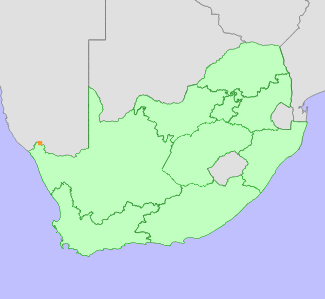|
Scientific Name | Conophytum ernstii S.A.Hammer subsp. ernstii |
Higher Classification | Dicotyledons |
Family | AIZOACEAE |
National Status |
Status and Criteria | Critically Endangered A3d |
Assessment Date | 2021/11/23 |
Assessor(s) | A.J. Young, P.G. Desmet, I. Ebrahim, D. Guo, A. Harrower, L. Jabar, L. Knoetze, C. Rodgerson, P.C.V. Van Wyk & N.N. Mhlongo |
Justification | This succulent is endemic to the Northern Cape province of South Africa where it is only recorded from two locations with an extent of occurrence (EOO) and area of occupancy (AOO) of 20 km². The dwarf succulents that comprise this genus have been increasingly targeted by illegal collection in recent years and the vast majority of species are in high demand by collectors. The population is already in decline due to an extended drought in the region. Whilst there is no evidence of illegal collection at the time of this submission, closely related species, including some from the immediate area, have been illegally removed from habitat with a dramatic increase in the number of species and volume of plants targeted since 2019. Although the locations are in a remote area, the threat of illegal collection is still regarded as very high especially given its limited distribution. Climate change is also impacting the population although there is uncertainty of the response given the expected resilience of this taxon. A decline of 80% of the population is likely within the next three generations (90 years). It therefore qualifies as Critically Endangered under criterion A3. |
Distribution |
Endemism | South African endemic |
Provincial distribution | Northern Cape |
Range | This succulent is endemic to the Northern Cape province of South Africa. |
Habitat and Ecology |
Major system | Terrestrial |
Major habitats | Noms Mountain Desert |
Description | This taxon is restricted to two, range-restricted, localities within the Desert biome where it receives winter rainfall. The plants are typically found on gneiss-quartzite at high altitude often on steep slopes. Plants often occupy shaded niches amongst large rocks or larger shrubs. This succulent has a generation length of 30 years. It is expected to be sensitive to the impacts of climate change as it does not disperse and while adapted to arid conditions, is dependent on limited seasonal rainfall. Drought related mortality has already been observed for this taxon. |
Threats |
| This particular succulent is not currently threatened by illegal collection but it is very likely that it will become a target in coming years as the majority of other species in the genus, including many from the region, have been increasingly targeted since 2019.
There is no decline in habitat quality for this taxon as inferred by changes in vegetation cover determined from changes in Enhanced Vegetation Index (EVI) between 1984 and 2018 using Landsat data (Venter et al. 2020). However, field observations in 2020-21 by SANParks have documented substantial declines in the population of this taxon. While it is not possible to model the response of this taxon to climate change due to its restricted distribution, the average loss to climate change for 21 more widely distributed Conophytum species occurring within the same region is used as an indication of likely impact to this taxon. Climate models for the likely emission scenarios where emissions stay at present day levels (RCP 2.6) (Hausfather and Peters 2020) and worst case scenarios where emissions continue to increase during the 21st century (RCP 8.5) indicate that there will be a loss of suitable bioclimatic envelope of between 56% and 86% by 2080 for Conophytum taxa within the region. However, as this taxon typically occurs in a sheltered habitat and possesses certain traits likely to afford resilience to xerophytic conditions it is expected to have a level of resilience to climate change and the expected population loss is reduced by 20% to 36%. Species in this genus have limited dispersal ability and migration to suitable habitats elsewhere is regarded as highly unlikely.
Mining and associated infrastructure are potential future threats to its habitat. |
Population |
It is known to be locally abundant however in response to an extended drought in the Richtersveld that started in 2016 and is still ongoing at the time of assessment, the population is in decline. An estimate of the population size made (SANParks survey 2021) indicated that there were 150,000 mature individuals of which more than 50,000 were dead. This taxon is restricted to a remote and relatively poorly explored areas so this may be an underestimate.
|
Population trend | Decreasing |
Assessment History |
Taxon assessed |
Status and Criteria |
Citation/Red List version | | Conophytum ernstii S.A.Hammer subsp. ernstii | CR B1ab(iii,v) | 2020.1 | | Conophytum ernstii S.A.Hammer subsp. ernstii | VU D1 | 2015.1 | | Conophytum ernstii S.A.Hammer subsp. ernstii | Rare | Raimondo et al. (2009) | | Conophytum ernstii S.A.Hammer subsp. ernstii | Lower Risk - Near Threatened | Victor (2002) | | Conophytum ernstii S.A.Hammer subsp. ernstii | Rare | Hilton-Taylor (1996) | |
Bibliography |
Hammer, S. 2002. Dumpling and his wife: New view of the genus Conophytum. EAE Creative Colour, Norwich.
Hammer, S.A. 1993. The genus Conophytum: A conograph. Succulent Plant Publications, Pretoria.
Hausfather, Z. and Peters, G.P. 2020. Emissions - the 'business as usual' story is misleading. Nature 577(618-620).
Opel, M.R. 2004. The rediscovery of Crassula alcicornis. Haseltonia 10:38-40.
|
Citation |
| Young, A.J., Desmet, P.G., Ebrahim, I., Guo, D., Harrower, A., Jabar, L., Knoetze, L., Rodgerson, C., Van Wyk, P.C.V. & Mhlongo, N.N. 2021. Conophytum ernstii S.A.Hammer subsp. ernstii. National Assessment: Red List of South African Plants version 2024.1. Accessed on 2025/11/07 |
 Comment on this assessment
Comment on this assessment


